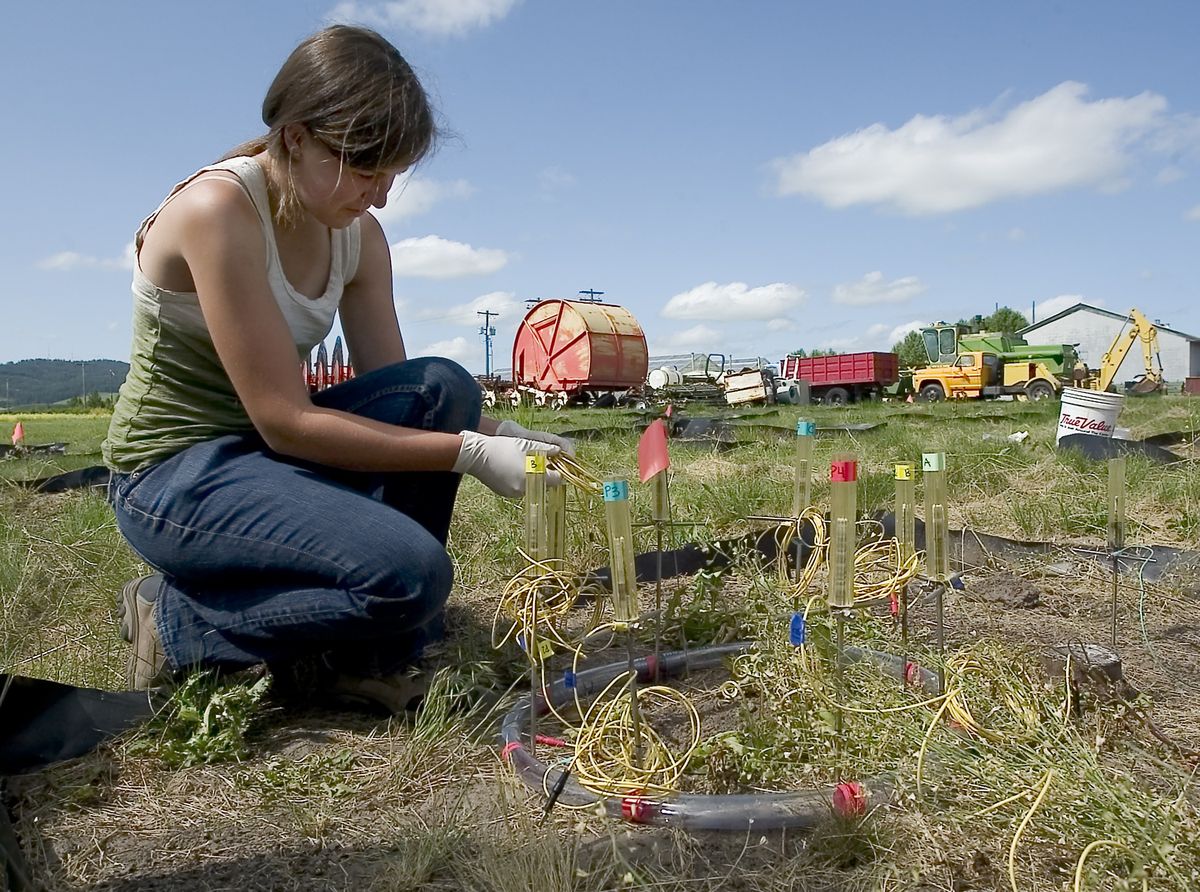Researchers search for specimens of rarely seen giant Palouse earthworm
This undated photo provided by the University of Idaho shows the rarely spotted giant Palouse earthworm, Driloleirus americanus. (File / The Spokesman-Review)
MOSCOW, Idaho – The giant Palouse earthworm has taken on mythic qualities in this vast agricultural region that stretches from Eastern Washington into the Idaho Panhandle – its very name evoking the fictional sandworms from “Dune” or those vicious creatures from the movie “Tremors.”
The worm is said to secrete a lily-like smell when handled, spit at predators, and live in burrows 15 feet deep. There have been only a few sightings.
But scientists hope to change that this summer with researchers scouring the Palouse region in hopes of finding more of the giant earthworms. Conservationists also want the Obama administration to protect the worm as an endangered species, even though little research has been done on it.
The worm may be elusive, but there’s no doubt it exists, said Jodi Johnson-Maynard, a University of Idaho professor who is leading the search for the worm. To prove it, she pulled out a glass tube containing the preserved remains of a fat, milky-white worm. One of Johnson-Maynard’s graduate students found this specimen in 2005, and it is the only confirmed example of the species.
The worm in the tube is about 6 inches long, well short of the 3 feet described by early observers of the worms in the late 1890s. Documented collections of the species, known locally as GPE, have occurred only in 1978, 1988, 1990 and 2005.
The farmers who work the rich soil of the Palouse – 2 million acres of rolling wheat fields near the Idaho-Washington border south of Spokane – also have had little experience with the worm.
Gary Budd, who manages a grain elevator in Uniontown, said no farmer he knows has talked about seeing the worm. He compared the creature to Elvis.
“He gets spotted once in a while too,” Budd joked.
Johnson-Maynard and her team of worm hunters are working this summer at a university research farm and using three different methods to try and find a living worm.
One involves just digging a hole and sifting the soil through a strainer, looking for any worms that can be studied.
The second involves old-fashioned chemical warfare, pouring a liquid solution of vinegar and mustard onto the ground, irritating worms until they come to the surface.
The third method is new to this search, using electricity to shock worms to the surface.
“The electro shocker is pretty cool,” said Joanna Blaszczak, a student at Cornell who is spending her summer working to find the worm alongside Shan Xu, a graduate student from Chengdu, China, and support scientist Karl Umiker.
The shocker can deliver up to 480 volts. That makes it dangerous to touch, and it could potentially fry a specimen.
On a recent day, Umiker drove eight 3-foot-long metal rods into the ground in a small circle and connected them to batteries. Then he flipped the switches. The only sound for several minutes was the hum of a cooling fan.
“I’m kind of bummed we haven’t seen anything yet,” Umiker said.
Eventually, a small rust-colored worm dug its way to the surface. It was not a GPE, but it was collected for study anyway.
The search for the giant worm is reminiscent of efforts in Louisiana, Florida and the swamps of eastern Arkansas to find the elusive ivory-billed woodpecker. The large, black-and-white bird was believed to be extinct until a reported sighting five years ago stirred national experts and federal funding to launch a full-blown campaign to verify its existence. Search efforts later dwindled after biologists and volunteers were unable to find the evidence they were looking for.
The GPE was described as common in the Palouse in the 1890s, according to an 1897 article in The American Naturalist by Frank Smith. Smith’s work was based on four samples sent to him by R.W. Doane of Washington State University in nearby Pullman.
Massive agricultural development soon consumed nearly all of the unique Palouse Prairie – a seemingly endless ocean of steep, silty dunes – and appeared to deal a fatal blow to the worm.
They were considered extinct when Idaho graduate student Yaniria Sanchez-de Leon in 2005 stuck a shovel into the ground to collect a soil sample and found the worm that now is in the tube in Johnson-Maynard’s office.
Conservation groups quickly petitioned the U.S. Fish and Wildlife Service to protect the worm as an endangered species, citing as proof the lack of sightings. But the agency said there simply was not enough scientific information to merit a listing.
Conservationists recently filed a second request, saying they had more information. They are also hoping the Obama administration will be friendlier than the Bush administration. The GPE would be the only worm protected as an endangered species.
Doug Zimmer of the Fish and Wildlife Service in Seattle said the agency isn’t ready to comment on the petition.
“It’s always good to see new information and good science on any species,” Zimmer said.
Farmers are keeping a wary eye on the process.
“The concern is whether a listing is going to end up curtailing farming activities,” said Dan Wood of the Washington State Farm Bureau. “I don’t know if people plan to stop all farming for the possibility of a worm being somewhere.”
Most earthworms found in the Northwest originated in Europe, arriving on plants or in soil shipped to the New World. The giant Palouse earthworm is one of the few native species, and has become quite popular with the public.
While it’s tough to come by a live GPE, visitors seem happy to take a picture with a dead one. Johnson-Maynard said she has received calls from tourists who want to come to her office and be photographed with the specimen.
“A lot of people are curious about it,” she said.

